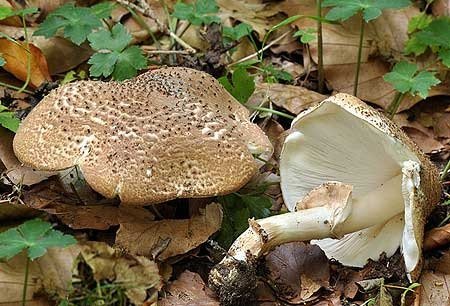Lepiota sharp-scaled (Echinoderm asperum)
- ڀاڱو: Basidiomycota (Basidiomycetes)
- ذيلي تقسيم: Agaricomycotina (Agaricomycetes)
- طبقو: Agaricomycetes (Agaricomycetes)
- ذيلي ڪلاس: Agaricomycetidae (Agaricomycetes)
- آرڊر: Agaricales (Agaric يا Lamellar)
- خاندان: Agaricaceae (Champignon)
- Genus: Echinoderm (Echinoderm)
- قسم: Echinoderma asperum (Lepiota sharp-scaled)
- Umbrella spiky
- Umbrella grungy
- Lepiota roughata

مٿو in lepiota sharp-scaled, it is first bell-shaped, then umbellate with a protruding tubercle, 5–10 cm in diameter. The color is light rusty-brown. The surface of the cap is covered with pyramidal, bristly, pointed, large scales, brown-brown, darker than the color of the cap.
رڪارڊ in Lepiota sharp-scaled very frequent, free, wide, frequent, white, when pressed and turning brown with age.
پيئي in Lepiota sharp-scaled it is even, 8-12 cm long and 1-1,5 cm in diameter, cylindrical with a swollen base, dense, smooth at the top, light, yellowish-brown below the ring, ocher-brownish, fibrous-scaly, at the base with brownish concentric scales . The ring is wide, thin, membranous, with a cobwebby veil when separated, white, cream, with ocher warts on the underside.
پل white, loose, with a nasty smell and taste.

The sharp-scaled umbrella grows from mid-August to the end of September (massively in the first half of September), in mixed forests, on rich soil, on rotten garbage, along roads, outside the forest, in parks, on lawns, singly and in groups, not often. Found in Europe and North America.
The sharp-scaled umbrella is considered an inedible mushroom due to an unpleasant odor and bitter taste (a decoction with an unpleasant resinous odor, and after cooling with a faint berry-fruit smell, when boiled, it emits the smell of burnt plastic or old fish oil, pulp of medium taste).
According to some foreign sources, it is deadly poisonous.
It differs from other terrestrial lepiotes of our forests in size and in recurved, protruding scales.









